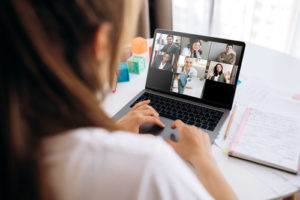The world has changed–and the fact is that all of our lives have been disrupted. And right now one of the most affected sectors is education, as students take finals on their kitchen tables or graduate from their living rooms, and teachers wrap up the semester with virtual goodbyes.
As the school year comes to an end, educators are looking at how our classrooms have changed over the past few months and the various possibilities of what the future of learning will hold.
Related content: Stepping away from technology to avoid burnout
And while my school, like many, has not made its final decision on how learning will take place in the fall, I’ve taken an opportunity to look back at the successes with online learning to understand how my class will forever be changed, for the better.
My biggest takeaway: Hybrid instruction is here to stay.
Traditionally, hybrid learning is defined as the combination of face-to-face and online delivery of course materials. The disruption of COVID-19 meant that all the face-to-face interactions for my classes took place online. However, I find that offering a blend of asynchronous and synchronous instruction has been key to the success of my virtual classroom.
Here are a few of the benefits of this approach, along with some strategies and tools that I will continue using in the coming school year, regardless of where learning takes place:
1. Meet students where they are: The shift to distance learning served as an important reminder for me that students have roles, responsibilities, and unique stresses associated with life outside of the classroom. Using a hybrid approach for distance learning, I continued to meet with students “face-to-face” using Zoom’s video conferencing. This allowed time to provide an in-depth explanation of the learning materials, offer real-time feedback, and make personal connections. Additionally, students who could not attend my virtual lessons were able to access a video recording of the lecture at a time that worked best for them, helping to reduce barriers for students who may have conflicting schedules.
2. Break down communication barriers: It’s also important to continue to offer students opportunities to ask questions in order to provide additional, targeted support. During the shift to distance learning, many students—especially those who are not comfortable speaking up during class or could not attend the synchronous lectures and Zoom office hours—were struggling with finding the right time and method to reach out. To help meet their needs, I ramped up my use of Numerade’s Office Hours feature, which allows me to answer students’ questions in the form of recorded videos enhanced by a virtual whiteboard. The recording uses a screen capture function, along with audio, to demonstrate the process of coming to a specific solution/answer. This tool made it easier for all students to reach out with questions about the learning materials at a time that worked for them and helped cut down on the amount of time I spent responding to similar questions by multiple students.
3. Provide real-time assessments: Prior to COVID-19, I spent many hours providing feedback on student work. When I shifted to working from home, I needed to shoulder more childcare duties, which limited the amount of time I had available to assess student work. To continue providing targeted and timely feedback, I began using Canvas, our online learning management system, to create and assign short online quizzes to gauge how well students understand each unit. Students also use it to evaluate their own progress. Many of these online quizzes are automatically graded to provide students with the immediate feedback they need, which helps to keep them engaged and in control of their own learning. Additionally, I leveraged online homework platforms like Sapling Learning to provide multiple practice problems with automated feedback.
While the future of learning is still so uncertain for many, it’s essential we take time to reflect on what worked and what didn’t over the past three months, so we can become even better at delivering instruction going forward. I plan to continue leveraging the tech-enabled strategies I adopted this spring to allow me to further connect with students, engage them in meaningful learning activities, and provide quality feedback, regardless of where learning takes place in the fall—at school, at home, or both.
- Fully Homomorphic Encryption can revolutionize education - April 29, 2024
- Survey: More students want to go to graduate school - April 24, 2024
- Educause, AWS launch generative AI readiness assessment tool for higher ed - April 23, 2024

